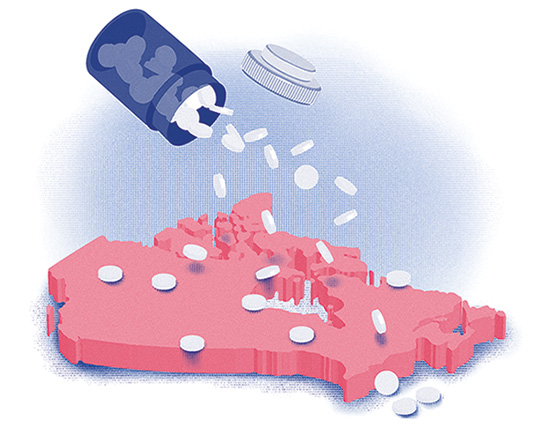The push for pharmacare
After decades of inaction, health experts say the time is now for national pharmacare in Canada
By Emily Leighton, MA’13

Dr. Danyaal Raza, MD’09, describes the current state of prescription drug coverage in Canada as a moth-eaten, patchwork blanket.
“The blanket is the net we catch people in to provide them with drug coverage,” he explained. “But there are a bunch of patches and holes with the stitching barely holding together.”
Raza is the past Chair of Canadian Doctors for Medicare and a family doctor with Unity Health Toronto based at St. Michael’s Hospital. He is a strong voice nationally advocating for universal, public pharmacare and access to medications.
“We’re closer now than we’ve ever been,” he said. “My hope is that our political leaders seize this moment and put the interests of Canadians first.”
Canada is the only high-income country with universal health care that does not provide universal drug coverage.

“My hope is that our political leaders seize this moment and put the interests of Canadians first.”
— Dr. Danyaal Raza
A recent study found roughly 1 in 5 Canadians either did not have prescription drug insurance or their insurance was inadequate in covering their medication needs. Other studies have reported that Canadians are giving up food and heat to cover the cost of their prescription medication.
“These numbers are quite staggering for a country with a health system founded on the principle of universal access to care,” said Dr. Shehzad Ali, Associate Professor, Epidemiology and Biostatistics and Canada Research Chair in Public Health Economics. Our health system is highly inequitable.
As a health systems researcher, Ali is concerned by the inequitable burden of out-of-pocket payments and the disproportionate impact on low-income households, racialized communities and other marginalized groups.
The Canada Health Act, passed in 1984, covers hospital and physician care, but leaves a lot of other health services out, including universal drug coverage. To cover the cost of prescription drugs, Canadians have had to rely on their employers or varying provincial plans tied to specific age groups and income thresholds.
“We have a regressive system that punishes people most in need of prescription drugs; where health is linked to wealth,” said Raza.
In the decades since the Act was passed, health care has changed significantly, and so too has the nature of employment. Chronic disease now plays a much bigger role in health care, and the gig economy means fewer people have access to employer-sponsored drug plans.

“These numbers are quite staggering for a country with a health system founded on the principle of universal access to care.”
— Dr. Shehzad Ali
If people aren’t able to pay for necessary medications, it can lead to avoidable health services costs. “There are significant downstream costs associated with poor access to medications,” said Ava John- Baptiste, PhD, a health economist and Associate Professor, Epidemiology and Biostatistics.
Canadians also pay some of the highest drug prices in the world due to a fragmented and opaque system of negotiation where each province and drug plan provider has historically negotiated separately with pharmaceutical companies.
“Despite efforts to consolidate the negotiation process through the pan-Canadian Pharmaceutical Alliance, there is room for improvement.”
“Pharmacare can further consolidate the negotiating process, provide increased bargaining power, and likely put downward pressure on drug prices,” explained John-Baptiste.
In 2019, the final report from the federal Advisory Council on the Implementation of National Pharmacare concluded that the program could lead to systems- wide savings of close to $5 billion annually.
Given the strong evidence and widespread support among Canadians, why do plans to implement national pharmacare keep stalling?
“If you look at who loses, it’s profitable pharmaceutical and insurance companies who will become a little less so,” said Raza. “This is what happens when we commodify and put health care in the free market.”

“Pharmacare can further consolidate the negotiating process, provide increased bargaining power, and likely put downward pressure on drug prices.” — Ava John-Baptiste, PhD
Raza says other countries, such as the United Kingdom and New Zealand, provide examples for how to balance public and private interests.
“The good news is, we don’t have to reinvent the wheel,” he said. “We also have 50 years of reports and commissions that have looked into this, answered the questions and come to the same conclusion that universal prescription coverage is fair and equitable, as well as cost effective.”
Cost effectiveness is something John-Baptiste focuses on in her research. She believes the Canadian Agency for Drugs and Technologies in Health, an independent, nonprofit organization that provides objective analysis and evidence on drug and cost effectiveness, can play an important role in this process by guiding health care decision-makers. “When we’re making decisions on how to allocate scarce resources, cost effectiveness is a prudent approach,” she said.
The structural and organizational changes required to implement pharmacare effectively won’t happen overnight, says Ali, but the government is in a strong position to start taking the necessary steps. “We need to look at the challenges and find a way to make this work,” he said.
Ali, John-Baptiste and Raza are all signatories on a letter signed by more than 1,000 experts in health care and public policy asking the Canadian government to increase the pace and scope of its commitment to national pharmacare.
“I do this work because this is a challenge I’m facing every day as a family doctor,” said Raza. “Words are not enough; we need to see concrete action. We know how to fix this, and we must fix it now.”








